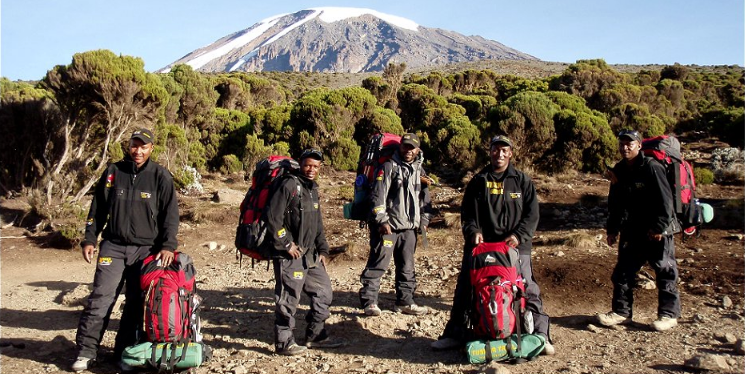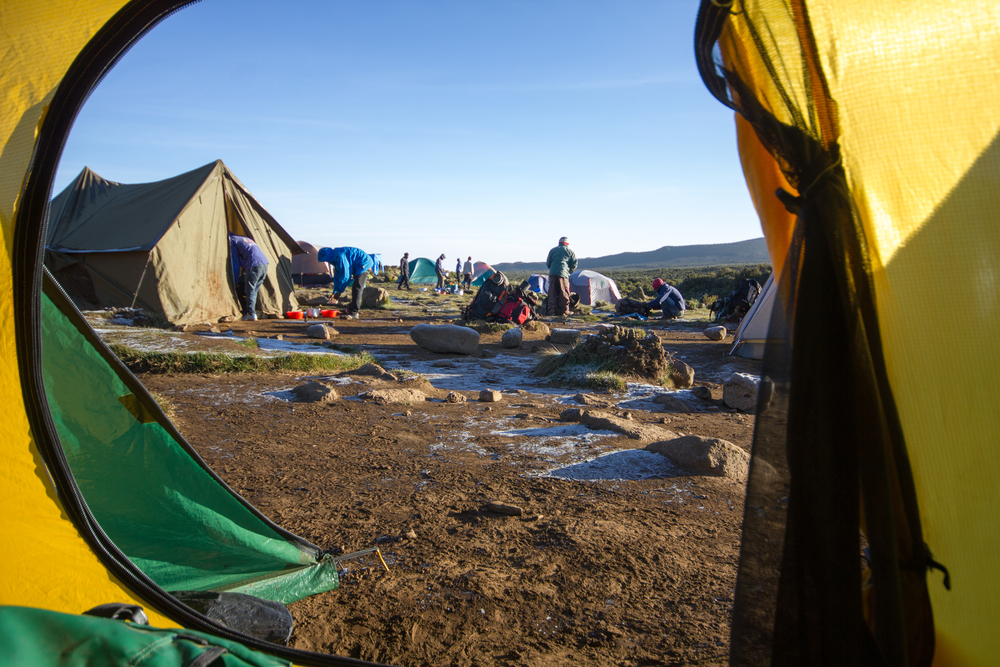Did you know you can’t climb Kili without a licensed and registered guide?
The government of Tanzania and the Mount Kilimanjaro National Park made it a rule that all treks up the mountain need a registered, licensed guide at the helm. That’s for a few reasons. Most importantly, a Mount Kilimanjaro hike can be dangerous. People die every year on the journey whether from weather-related accidents, altitude complications, or other unforeseen issues. And also to make sure that climbers stick to the many rules established by the government to reduce the human impact on the sensitive environment.
Since you can’t climb Kilimanjaro alone, and you want to make it to Kilimanjaro’s summit safely, how do you find the right guide to lead you on your adventure?
Since this is one of the biggest expenses contributing to your cost to climb Mount Kilimanjaro, we’re going to talk about 6 signs that you know you’re booking with a fully reliable and professional Kilimanjaro guide.
6 Tips for Booking an Experienced Guide to Climb Kili
Look for a trekking company with guides that check the following boxes:
1. They have a valid Kilimanjaro climbing operator’s license
What certifications should you look for? All tourism companies need to be registered with the national park and have a valid operator’s license. This shows that they follow the rules and pay their taxes to the local communities.
2. They work with guides who have many years of experience climbing Kilimanjaro
How can you tell if your guides have the necessary experience to handle whatever the trail throws your way?
Check for guides who bank years of experience on the mountain and know every inch of the routes. Our awesome team of Tusker guides have been with us long enough to become family — their experience ranges from 10–20 years!
3. They provide a safe number of guides and porters per climb
The number of guides on your Mount Kilimanjaro hike will depend on several factors, such as how many climbers will be in your group, the route you’re taking, etc.
Companies that are trying to cut corners will only allocate the fewest guides and porters they can so they don’t have to pay for their services. Some only feed their porters once a day and force them to work for tips only instead of a living wage.
4. They will conduct medical monitoring during your climb
Find a company whose guides know exactly how to monitor you medically, on a regular basis during your ascent and descent.
Your guides should be watching your back every step of the way and should be comfortable using medical equipment like stethoscopes, pulse-oximeters, and supplemental oxygen, as well as be able to make an immediate medical assessment of you. Though you don’t need oxygen to make it to the summit, our guides carry extra oxygen for emergencies. Whether it’s from having the extra oxygen or simply having peace of mind knowing it’s there, 98% of our climbers successfully reach the top of Kilimanjaro.
Our guides also carry a Portable Altitude Chamber on every climb. This artificial pressure chamber simulates pressure at lower altitudes. It’s key to saving lives and for handling acute mountain sickness (AMS) before it gets serious. It’s a proven lifesaver.
5. Their guides have relevant high altitude medical training that will keep you safe
Accidents happen all the time on the trail. So, how can you tell if your guides have the necessary safety training to deal with emergencies on the mountain?
People all respond differently to the effects of altitude. A well-trained guide (along with the right support team) will know how to look for the symptoms of slow acclimatization and could mean the difference between life and death in the event of a high altitude emergency.
Tusker is the only Kilimanjaro company that trains its guides with a High Altitude First Responder medical course, which prepares all of Tusker’s guides for emergencies that commonly happen at high altitude on a Mount Kilimanjaro hike. This comprehensive course was designed by the founder of Tusker Trail, Eddie Frank, and was specifically created to climb Kili the safest way possible.
Tusker’s guides are so skilled at treating sick and injured climbers that they’re often called to the rescue when the National Park (and other climbing companies) needs assistance with emergency treatment or evacuations.
6. They are adamant about not using subcontracts nor using gear from a third-party provider
Most companies selling Kilimanjaro climbs are just agencies, and don’t run their climbs with their own guides and equipment. Instead, they subcontract your climb to a local climbing company; most often the cheapest. But this means you can’t vet the experience of the guides or the quality of their equipment.
We know that one can’t perform their job well without the right tools and equipment to do so. That’s why all our guides and porters are fully-equipped and supported during their climbs. They don’t need outside help like other companies on Kilimanjaro.
Speaking of companies you may want to avoid…
3 Red Flags to Watch Out For
Are there any red flags or warning signs that you may be booking with an inexperienced crew?
If you spot these safety issues when you’re booking a Mount Kilimanjaro hike online, it’s best to avoid them.
Red flag#1: The price is too cheap
There are several factors that go into the cost to climb Mount Kilimanjaro. When your safety, health, and summit is at stake, why would you hire the lowest bidder? Aside from supplying your food and paying your park entrance fees, a large portion of your trip’s cost will go to the guides and porters making your journey safe and unforgettable.
Depending on the route you choose, you could pay anywhere from $600-$1,500 for park entrance fees for you alone. So companies charging less than $2,000 for their climbs must be cutting corners somewhere — and that’s usually with their guides and porters.
We do more than just take care of our crew here at Tusker. They are our most important asset. They’re family.
Not only do we pay our guides and porters extremely well, and way above the average wage standards, our crew:
- Receive the same medical monitoring and wellness checks on the trail as our climbers.
- Adhere very strictly to the porter load limits set up by the National Park authorities.
- Have a dedicated chef and kitchen to prepare regular hot meals for them.
- Use heavy duty all-weather mountain tents for sleeping.
- Receive health insurance. The health policy covers the crew member plus nine members of his immediate family.
- Get their wages and tips distributed transparently with everyone present the day after the climb ends. The tips are divided according to job status and responsibility. We also audit the tip process regularly to make sure everyone’s happy.
- Doesn’t have to work forever. Tusker contributes annually to a pension fund we have established for all our Kilimanjaro mountain guides.
- Has access to the Tusker Education Fund, which provides scholarships for needy kids in the Kilimanjaro community.
Red flag #2: They don’t have their own evacuation plan
While climbing Kili, you may have an emergency that requires a skilled evacuation. Tusker’s medical training and protocols have been tested over the years — and have saved many lives.
We don’t have to rely on outside help to get you critical attention fast. Our medically-trained guiding team is on the ball and will evacuate you skillfully, promptly and efficiently.
Red flag #3: They offer very short ascents up the mountain
Beware of climbs lasting less than a week. You’ll have the highest chance of reaching the summit if you spend more time you spend acclimatizing to the high altitude. More time getting used to the altitude means more time spent climbing Kili.
The reason many companies offer shorter treks is because they can sell a climb for a cheaper price.. But none of that will be worth it if you can’t take a selfie at the summit or if it puts you and your team in danger.
Tusker Guides are the Real Deal
Our guides know that the health and safety of all our climbers is our number one priority. That’s why:
- Tusker uses more guides per group than any other Kilimanjaro company. You’ll have anywhere from 2–6 guides per group, and if you’re climbing on your own you’ll have your own personal guide.
- We know experience matters. After our first climb 42 years ago, Tusker has focused tons of resources on maintaining a solid crew. Most of our staff has been working with us for the past 10–20 years. With virtually no turnover, our crew is fiercely loyal to the Tusker family and operates as a family and a finely-tuned machine.
- We have a doctor on call. Dr. Greg Bledsoe serves as Tusker’s on-call resource for all medical questions. As one of the top Wilderness Medicine specialists in North America, he spent five years on faculty in the Johns Hopkins Department of Emergency Medicine. Dr. Bledsoe has also been an instructor and medical consultant for the United States Secret Service. Through his contacts, our Tusker guides have access to a vast array of medical resources, research, and personnel that other companies do not.
Ready to Climb Kili with the Best?
Tusker’s highly skilled guides are in a league of their own.
Trained every year in Tusker’s unique High Altitude First Responder medical course, they are highly respected on Kilimanjaro and exhibit rare leadership qualities that instill confidence in both veteran and first time climbers.
Their comprehensive medical training will make your Mount Kilimanjaro hike safe, fun, and successful. Since your guides are the key to you reaching the summit, why take a chance on a crew you can’t trust?
Check how much it will cost to climb Kilimanjaro and get started on the adventure of a lifetime.




